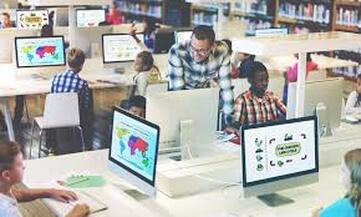 It seems like the words “school choice” have been identified by many as words that have become offensive in the lexicon of public education. Just as Auntie Maxine (Rep Maxine Waters (D-CA)) reclaimed her time on the floor of the US Congress, I want to reclaim this term. In Arizona school choice means that there is open enrollment for all school districts in the state. However, even the term “open enrollment” has been used as a dog whistle to mean “those kids” who don’t live in a particular neighborhood. With schools, for the time being, and hopefully at least until January 2021, going online, what does school choice look like as parents begin to send their children either back to their traditional school via online distance learning, or choose another option that might best fit their needs? School choice for a family is a personal matter. As we know, the personal is political. Choices are not made in a vacuum, and oftentimes with varying degrees of information, some valid and some not as valid. No matter what position one takes, concerning school choice, it is important to appreciate that every school is a “selective enrollment” school. Meaning, if you have the means to live in an area with high property taxes and good schools, you have made a selective, conscious choice. There is a saying in education that zip code should not determine your educational outcomes. Arizona, in having open enrollment, in theory has addressed this issue. In practice, there is something entirely different taking place. Even with most schools going online at least for the next month or two, the disparities and inequalities of what online looks like are tremendous. Some districts have the resources to purchase Chromebooks (or other laptops) and distribute them to every student (in what is called a 1:1 ratio), while others are scraping together funds to come up with technology for students in their districts. Same holds true for internet access. We know that there are companies who are working with districts in some areas to provide service, but still at a cost. In certain parts of urban and rural areas, even with the improvements, the service remains spotty. Lastly, and perhaps the most egregious, are the teachers and their preparation for online distance learning. Teaching in the age of a pandemic meant many teachers did not have a full summer of not only decompressing from a very challenging last quarter of school, but also the nontraditional task of having to start their planning and development for the 2020-21 academic year far earlier than usual. In regard to some teachers being reticent about returning to the physical classroom, people have quickly gone from hero worshiping teachers to demanding that they are somehow “weak” or “selfish” for not wanting to put their lives at risk by entering the classroom. Some have even gone so far as to compare them to other front-line workers. These false equivalencies are grounded in many ways by gender, but also by class. As I mentioned in my last blog about ‘pandemic pods,’ those who have a way for their child to be out of the classroom and still experience face to face learning have found a way, those who do not have that option, have not. They are the ones most in need of teachers who know how to provide brilliant social emotional connections as well as pedagogy for students who are longing to get back to learning. So, what is this learning going to look like for the foreseeable future? It depends on where you are and the familiarity your teacher has with both the training to provide online distance learning and their comfort level with the technology to implement said pedagogy. I was recently reminded of an fundamental theory that was the foundation for my dissertation work and something that I still hold as one of the most important aspects of a “good” school, no matter the structure (e.g., online, face to face, traditional, charter, etc…). Anthony Bryk in 2010 expanded on his work done in the early 2000s on trust in schools with Barbara Schneider to articulate five essential ingredients for school improvement. I would argue, these five tools should not only be a guide for schools that are in need of reforms, but also schools that are transitioning to online distance learning, or other forms of non-traditional instruction that will be needed as we move forward in public education.
Education, like so many things in our society, has been commodified and packaged. As such, many have employed the same mentality as if they were going shopping. If I can afford better, I should get better. Equity does not mean everyone has the same thing; it means that we make sure that the “least of thee” at least has everything they need to be successful. Schools are in the “business” of attracting us with the bells and whistles that they can provide, but they should also be in the “business” of creating opportunities for academic growth that include not just who has the most, but who learns about the diversity and complexities of this country. Schooling has changed and we, as parents, must quickly adapt, be equipped with important data, and use due diligence. In utilizing Bryk’s (2010) work, in my previous blog from 2016 I posted my version of the five qualities that signify a “good” school culture based on our search for a school for our first child when we he was about to enroll in kindergarten. Here is the updated list.
0 Comments
Leave a Reply. |
|
